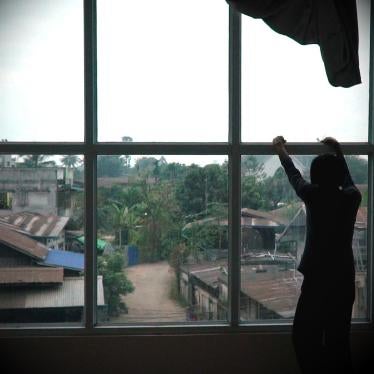(エルビル) ― イラクのクルド自治政府の治安部隊(ペシュメルガ)は、ISISから奪還した地域のアラブ系住民の家屋多数や、一部では村全体を不法に破壊してきたと、ヒューマン・ライツ・ウォッチは本日発表の報告書内で述べた。
報告書「つけられたX印:ISISとの戦闘でクルド自治政府部隊に破壊された村や家屋」(全80ページ)は、名目上はイラク政府の管轄下にあるが、実際はクルド自治政府(KRG)が統治するキルクークおよびニネベ県の紛争地域で、2014年9月〜2016年5月に起きた家屋の破壊を調査したもの。破壊はKRGのペシュメルガ部隊がイスラミックステート(ISIS)戦闘員を駆逐したのちに起きた。クルド系住民の家屋は無傷な一方で、アラブ系住民の家屋が標的にされた。KRG指導者たちは、これら地域が歴史的にクルド人のものであり、クルディスタン地域に組み込む予定であるという考えを維持している。
ヒューマン・ライツ・ウォッチの中東局長代理ジョー・ストークは、「キルクークとニネベ県の村という村で、ペシュメルガ部隊がクルド系住民を除くアラブ系住民の家屋を、正当な軍事目的がないのに破壊した」と述べる。「KRG指導者たちの政治的目標が、不法な住宅破壊を正当化することはない。」
ペシュメルガ部隊がイラクの主要都市モスル周辺の村落をISISから奪還しつつある今、米国主導の有志国連合はKRG指導者とペシュメルガ部隊の士官に対し、これらの不法な攻撃をやめるよう強く求めるべきだ。
本報告書はヒューマン・ライツ・ウォッチ調査員たちによる現地調査に基づいている。120人超の目撃者および関係者に聞き取り調査を実施し、衛星画像の詳しい分析を行った。また、キルクーク県17村とニネベ県4村で、家屋破壊状況を詳しく調査し、シリア国境に近いニネベ県内のその他の村落もまわった。
これら21の町村のうち、特に重大な破壊のあとが残る13町村を訪問したところ、3町村を除くすべてにおいて、建物の少なくとも半分はがれきと化しており、7町村では住民が完全に避難していることがわかった。他62の町村でも、ISISがこれらの地域から撤退する前の空爆や大規模火災による破壊とは明らかに異なる、火・重機・強力な爆発物の使用による重大な破壊のあとが、衛星画像から明らかになっている。しかし、証言がそろっておらず、これら地域がどんな状況で破壊されたか、また誰に責任があるか完全な特定はできていない。
ニネベ県では、アラブ系とクルド系の混在する町バルディア、アラブ系地区とクルド系地区のあるハマド・アガ(Hamad Agha)、近くにあるアラブ系の村シェイクハン(Sheikhan)を訪問した。どちらの町村でも地元のクルド系住民は、ペシュメルガがクルド系ではなく、アラブ系の家屋を破壊したと話した。
キルクーク県では、アルムーラ(al-Murra)村の住民数人がヒューマン・ライツ・ウォッチに、ペシュメルガが2015年7月にISISとの短い戦闘を経て支配を回復した後、村を破壊するのを目撃したと語った。その際に、地元の学校なども爆破された。KRG幹部は、住民がISISの支持者だったためだと主張している。 しかし、一連の家屋破壊は、絶対的な軍事上の必要性がある場合を除き、民用物の破壊を禁ずる武力紛争法に抵触しているとみられる。
KRGとペシュメルガの高官はヒューマン・ライツ・ウォッチに対し、一部の民用物破壊は、米国主導の反ISIS有志連合の空爆とペシュメルガ部隊の砲撃によるものと述べた。これはヒューマン・ライツ・ウォッチによる衛星画像の事前・事後分析の一部と一致する。しかし圧倒的多数のケースで、攻撃が終わりKRGが支配を握った後のブルドーザー、火、強力な爆発物(鉱山や爆発物の除去に用いられる安全性の低い方法)の使用と一致する破損パターンを示している。
KRGとペシュメルガの高官はまた、ISISがにわか作りの地雷や爆発装置を家屋に仕掛けていったため、破壊しなければならないことが多々あったと述べている。しかし地雷除去の専門家たちは、このやり方は受け入れられてきたやり方に反しており、コントロールが効かない爆発は、がれき全体に爆発物をまき散らし、該当地域およびその後の除去作業が非常に危険なものになると指摘する。
多くの場合、家屋や村落の破壊は、ペシュメルガがふたたび当該地域を掌握してから数週間、数カ月後に起きている。このことが示すのは、ISISが仕掛けた爆発物の除去がKRGの軍事作戦にとって重要なものではなかったということだ。よって、民用物への攻撃の正当化には絶対的な軍事上の必要性を要する、国際人道法の要件も満たしていない。
ISISに1度も掌握されたことのない村落にある建物を、ペシュメルガが破壊したケースも複数あった。これに関してKRG指導者たちは、これら建物に 1人かそれ以上のISIS支持者が住んでいたために破壊したと主張している。
2016年7月の会談で、KRGのマスウード・バルザーニ大統領はヒューマン・ライツ・ウォッチに対し、サダム・フセイン元イラク大統領の下で「アラブ化された」村々を正統なクルディスタン地域であると考えており、スンニ派のアラブ人の帰還を許可するつもりはないと述べている。このような領土の主張は、ペシュメルガがアラブ系住民の帰還を防ぐ、または思いとどまらせる目的で破壊を行ったという、当該紛争地域の多くのアラブ系住民の考えに信憑性を与えるものといえる。 武力紛争法は、敵対勢力が軍事目的で利用している場合を除いて、民用物への攻撃を禁じている。加えて村落全体など、地域一帯を軍事目標として無差別に攻撃することも違法だ。
クルド当局はより最近の破壊・撤去の動きにおいて、従来のアラブ系住民と、2016年10月21日のISISによるキルクーク県への攻撃のあとに国内避難民となったアラブ系の人びと少なくとも325人を立ち退かせた。当局は更に、最低でも100件の家屋を破壊した。これに至るまでの数日間、ヒューマン・ライツ・ウォッチは2016年9月〜10月12日までの衛星画像を検証。85軒の破壊された建物を確認した。これらの画像から、破壊の大半が9月11日〜27日にかけて起きたこと、そしてそれがキルクーク県南部の「June First」地区だったことが明らかになった。この地区には、キルクーク県に長年暮らしてきたアラブ系住民、2007年のディヤラおよびバグダッドで起きた戦闘を逃れてきた家族、そして2014年にISIS支配地域から避難してきたアラブ人などが混在して暮らしていた。
KRGは、これら報告書に詳述されている国際法違反が疑われる事案を捜査し、その責任を負う者の罪を問うべきだ。KRG軍に軍事援助している米国、ドイツなどの国々は、地方政府に対し捜査を実施するよう圧力をかけるべきである。 国連人権理事会は、人権高等弁務官事務所のISISによる人権侵害の捜査権限を拡大し、ペシュメルガを含む、紛争の全当事者の深刻な違反行為を含むようにしなければならない。
前出のストーク局長代理は、「KRGによるアラブ系住民の家屋や村落の不法な破壊パターンは、それ自体が非常に深刻なものである」と指摘する。 「しかしそれ以上に、たとえKRGと有志国連合軍がモスルやそのほかのイラクにおける支配地域からISISを撤退させたとしても、今後も続く争いの種をまいてしまっている。」
New Cases of Unlawful Home Destruction and Displacement by Kurdish Forces
Qarah Tappah, Kirkuk Governorate, October 2016
Aid workers told Human Rights Watch that on October 9, 2016, Kurdish forces, including Peshmerga, Asayish, and Kirkuk police, surrounded the Kirkuk governorate Arab village of Qarah Tappah, 14 kilometers west of the city of Kirkuk, and forcefully displaced between 3,000 and 4,000 residents. The security forces summoned residents to the main mosque and ordered them over the loudspeakers to leave their homes. Two hours later, the authorities went door to door, without showing any written eviction order, and gave residents two to three hours to gather their belongings. They then bused the residents to Daquq camp for internally displaced people, about 30 kilometers south of Kirkuk. As far as Human Rights Watch has been able to determine, the authorities gave none of the families any reason for the evictions or any compensation.
At the time of the displacements, the village was about 30 kilometers from the nearest front line and there had been no explosions or other reported security incidents there that would have indicated that the village was unsafe for residents who wished to remain. There are no known key military structures in the village. Human Rights Watch attempted to visit Qarah Tappah but was refused entry by Peshmerga at the village entrance. The village appeared to be deserted except for several patrolling Peshmerga. Researchers could observe near the village entrance some of the homes whose destruction is documented in the report (pages 23-27). The local Peshmerga commander, when asked, said that there had been no further destruction of homes since those documented in May 2016. One displaced resident later told Human Rights Watch that Peshmerga torched a number of homes, including his own and his brother’s, but declined to say how he knew this.
Qutan, Kirkuk Governorate, October 2016
Human Rights Watch visited Qutan, a mainly Arab village 18 kilometers northwest of Kirkuk, on November 8, and found that virtually the entire village had been destroyed or heavily damaged – according to villagers, approximately 90 out of 100 homes. Only the homes of 10 or so Turkmen and Turkmen-Kurdish families remained intact.
Several residents who had come back to retrieve some belongings said that in the early morning hours of October 21, the day of a large-scale ISIS attack on Kirkuk, a dozen or so ISIS fighters entered the village around 4 a.m. and took over the mosque, raised the ISIS flag, and used the loudspeaker to harangue the residents to support ISIS. Several residents said they notified the nearby Peshmerga post. Peshmerga forces arrived around 9 a.m., the ISIS fighters fled, and “it was quiet by 10 a.m.,” as one resident put it. A resident of a nearby village told Human Rights Watch that he had heard gunfire from Qutan at the time. A resident from Qutan told Human Rights Watch that two Peshmerga and one villager were wounded in the attack. He also said that the ISIS fighters commandeered the car of a villager, filled it with explosives, and blew the car up at a Peshmerga checkpoint on the highway not far from the village, causing additional Peshmerga casualties.
Four Qutan residents said the Peshmerga then took about 70 village men to a Peshmerga base across the highway, and told the remaining Arab families to leave and to go stay with relatives. After two days, they transferred the men to an Asayish base. Asayish officers released them all over the course of the third day.
Abdullah Taleb Abdullah, a 37-year-old lawyer, said he was not forced to leave right away because he spoke Kurdish, although his two homes were among those demolished. He said that the Peshmerga brought in front-loader tractors (he referred to them as “shovels”) the same day and began hacking at homes.
A 50-year old oil company employee told Human Rights Watch that he had left the village the previous day:
On Friday, a friend called and told me Peshmerga were looting the village. I called a security officer I knew in Kirkuk and asked him to take me to the village. He agreed, and we arrived around 3:30 p.m. The Peshmerga didn’t let me to go inside [the village]. I stayed on the main street trying to convince them to allow me in when I saw a white pickup pulling my Toyota Corolla. A guy wearing a Peshmerga uniform was in my car. When I told him it was my car he said, “And now it is mine.” A Kurdish neighbor convinced him to give my car back. The next morning, I asked some Kurdish friends from Kirkuk to help me to get my other car. When we came to the village, I took out my car. I saw people wearing Kurdish clothes looting our houses, and I could not say anything to them. I saw the houses close to the main street were destroyed.
Abdullah Taleb Abdullah said that over the next two days, Kurdish forces – this time Asayish, he said – brought in two bulldozers and proceeded to seriously damage and demolish homes. When he asked why they were destroying homes, he said the response was, “Why didn’t you fight ISIS.” All of the residents said the ISIS attack early on the morning of October 21 was the first Qutan had experienced, although there had been ISIS activity in areas nearby, and that there were some known sympathizers in the village.
Qoshkaya, Kirkuk Governorate, October 2016
A displaced resident from the Arab village of Qoshkaya, a dozen or so kilometers north of Qutan, told Human Rights Watch that over the course of several days beginning on October 24, Peshmerga forces forced them to leave their homes. Human Rights Watch had visited Qoshkaya in May to document the destruction of about 30 homes a year earlier, as documented in the report (page 36). When researchers visited again on November 8, they found many more homes bulldozed or torched, as well as the primary school and medical clinic.
The village was entirely deserted of residents, but researchers observed perhaps half a dozen small groups of Kurdish-speaking men with pickups and medium-sized trucks – in one case two men in Peshmerga uniforms – looting belongings such as refrigerators, washing machines, windows, and door frames.
Researchers spoke with a man and woman in a much smaller Kurdish village of the same name just across the highway. When asked why the Arab village was empty and houses destroyed, the man replied, “They were Arabs, they were ISIS, relatives if not directly.” Both Qoshkaya and Qutan, the woman said, were home to “known troublemakers.” Before ISIS emerged in 2014, they were Al-Qaeda and Baathists, she said.















